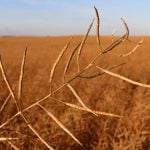Chris Gillard of the University of Guelph summed up his view of the Western Bean Cutworm this way:
“This thing scares me more than anything else I’ve worked with,” said the pulse crop specialist at the Manitoba Special Crops Symposium.
It’s a pest in edible beans and corn – big Ontario crops – and also in peas – not a big Ontario crop. But here’s the ugly reality for Western Canada: it has been causing big damage to Ontario pea growers, and they harvest their crop in July, before the bug is fully active as a pest. If the crop gets out to the big pea fields of Saskatchewan . . .
The Western Bean Cutworm began to be noticed in Nebraska about 60 years ago and was a localized problem, until about a decade ago. Then the worm began to crawl. It moved east through the western and eastern corn belt of the U.S., then hooked up north into Michigan – big edible bean country – in 2006 and into southern Ontario in 2008.
It revels in corn and bean crops, so Ontario is an unfortunately good home for it. But Gillard said the pea growers of Western Canada should be scared, because this bug has a powerful hunger for peas, and on the prairies farmers don’t harvest that crop until the end of the summer, possibly allowing the bug to cause big damage. The bug burrows into pods and eats the seeds. In Ontario, peas are grown for the fresh market and harvested by the end of July, so the bug is only getting going by then. In the West peas are hanging out in the fields for weeks longer.
Manitoba would be a good base for the pest, since corn and edible beans are big crops in the Red River valley.
But very little is known about the bug outside of Nebraska. Can it spread up north to the brutal winter colds of the prairies? Here’s what Gillard told me after his presentation:
“The big question is: do they overwinter? There’s so much we don’t know about this bug.”
That’s why he was suggesting prairie farmers and ag industry folk start putting up the milk jug traps to catch the moth form of the bug.
“They are moving and you should at least know when they’re coming in.”
You can follow Ed’s posts on his blog, here.









